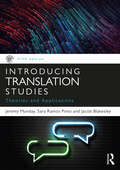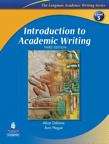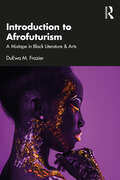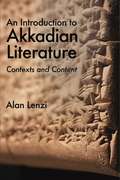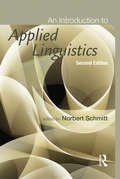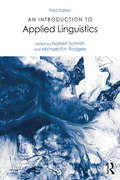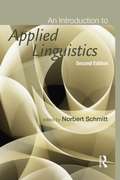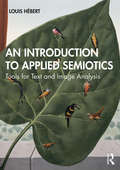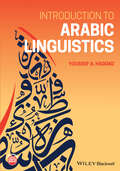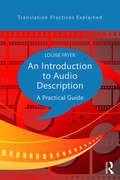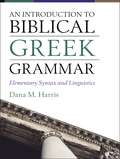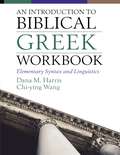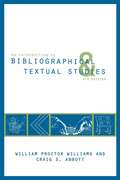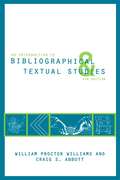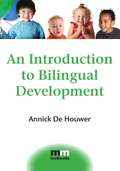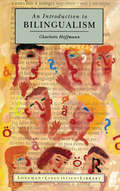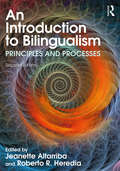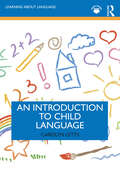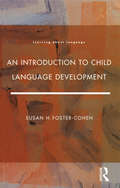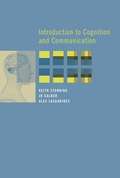- Table View
- List View
Introducing Translation (Cambridge Introductions to Applied Linguistics)
by Kirsten MalmkjærConnecting theory, practice, and industry, this innovative introduction to the complex field of translation takes a can-do approach. It explores the latest advances in both research and technology, considers the importance of different genres and contexts, and takes account of developments in our understanding of the mental and physical processes involved. Chapters covers four main areas: what we know and how we acquire knowledge about translation, what translation is for, where and how translation happens, and how to do it. There are 40 illustrative exercises throughout, designed to cement understanding and encourage critical engagement, and recommendations for further reading are provided to allow more in-depth exploration of specific topics. Introducing Translation is a cutting-edge resource for advanced undergraduate and graduate students in languages, linguistics, and literatures.
Introducing Translation Studies: Theories and Applications
by Jeremy MundayIntroducing Translation Studies remains the definitive guide to the theories and concepts that make up the field of translation studies. Providing an accessible and up-to-date overview, it has long been the essential textbook on courses worldwide. This fourth edition has been fully revised and continues to provide a balanced and detailed guide to the theoretical landscape. Each theory is applied to a wide range of languages, including Bengali, Chinese, English, French, German, Italian, Punjabi, Portuguese and Spanish. A broad spectrum of texts is analysed, including the Bible, Buddhist sutras, Beowulf, the fiction of García Márquez and Proust, European Union and UNESCO documents, a range of contemporary films, a travel brochure, a children's cookery book and the translations of Harry Potter. Each chapter comprises an introduction outlining the translation theory or theories, illustrative texts with translations, case studies, a chapter summary and discussion points and exercises. NEW FEATURES IN THIS FOURTH EDITION INCLUDE: new material to keep up with developments in research and practice, including the sociology of translation, multilingual cities, translation in the digital age and specialized, audiovisual and machine translation revised discussion points and updated figures and tables new, in-chapter activities with links to online materials and articles to encourage independent research an extensive updated companion website with video introductions and journal articles to accompany each chapter, online exercises, an interactive timeline, weblinks, and powerpoint slides for teacher support This is a practical, user-friendly textbook ideal for students and researchers on courses in Translation and Translation Studies.
Introducing Translation Studies: Theories and Applications
by Jeremy Munday Sara Ramos Pinto Jacob BlakesleyIntroducing Translation Studies remains the definitive guide to the theories and concepts that make up the field of translation studies. Providing an accessible and up-to-date overview, it has long been the essential textbook on courses worldwide. This fifth edition has been fully revised, and continues to provide a balanced and detailed guide to the theoretical landscape. Each theory is applied to a wide range of languages, including Bengali, Chinese, English, French, German, Italian, Punjabi, Portuguese and Spanish. A broad spectrum of texts is analysed, including the Bible, Buddhist sutras, Beowulf, the fiction of Proust and the theatre of Shakespeare, European Union and UNESCO documents, a range of contemporary films, a travel brochure, a children's cookery book and the translations of Harry Potter. Each chapter comprises an introduction outlining the translation theory or theories, illustrative texts with translations, case studies, a chapter summary, and discussion points and exercises. New features in this fifth edition include: New material to keep up with developments in research and practice; this includes the sociology of translation chapter, where a new case study employs a Bourdieusian approach; there is also newly structured discussion on translation in the digital age, and audiovisual and machine translation; Revised discussion points and updated figures and tables; New in-chapter activities with links in the enhanced ebook to online materials and articles to encourage independent research; An extensive updated companion website with video introductions and journal articles to accompany each chapter, online exercises, an interactive timeline, weblinks, and PowerPoint slides for teacher support. This is a practical, user-friendly textbook ideal for students and researchers on courses in translation and translation studies.
Introducing Writing Across the Curriculum into China
by Dan WuDr. Wu Dan's Introducing Writing Across the Curriculum into China is an important and provocative research study that is broadly international in scope. Of particular significance for education in China, this book provides a historical analysis of writing instruction in China and an original application of activity theory used to analyze problems and possibilities for Writing Across the Curriculum (WAC) in higher education. Through an examination of important aspects of WAC as it has developed in the United States, Dr. Wu Dan brings together various perspectives in support of developing and sustaining WAC programs in China and by analogy throughout the world. Her work opens new avenues for research in writing and for the teaching of courses throughout the curriculum using a writing-in-the-disciplines approach. A major contribution to international WAC scholarship, Introducing Writing Across the Curriculum into China will be invaluable to English faculty and to all readers interested in educational innovations in China.
Introduction to Academic Writing
by Ann Hogue Alice OshimaThe Third Edition of Introduction to Academic Writing, by Alice Oshima and Ann Hogue, continues in the tradition of helping students to master the standard organizational patterns of the paragraph and the basic concepts of essay writing. The text's time-proven approach integrates the study of rhetorical patterns and the writing process with extensive practice in sentence structure and mechanics. Features of the Third Edition: A step-by-step approach guides students seamlessly through the process of writing. Clear, succinct explanations help students to understand and apply key concepts and rules. Numerous models and varied practice support students at all stages of writing. NEW instruction and practice in summary writing prepare students for academic work. NEW Try It Out! exercises give students opportunities to assess mastery of skills. NEWself-editing and peer-editing worksheets motivate students to revise their work. Introduction to Academic Writing is also available with CriterionSM Publisher's Version, which provides instant online feedback on student writing: Students simply submit their writing online and instantly receive personalized feedback on: Grammar, Usage, Style, Mechanics, Organization, and Development (essays only). Students can turn in better writing, and teachers can save time spent correcting drafts. Clickon the "Resources" link to order the edition with CriterionSM Publisher's Version The Longman Academic Writing Series consists of: Level 1 Fundamentals of Academic Writing Level 2 First Steps in Academic Writing, Second Edition Level 4 Writing Academic English, Fourth Edition.
Introduction to Afrofuturism: A Mixtape in Black Literature & Arts
by DuEwa M. FrazierIntroduction to Afrofuturism delivers a fresh and contemporary introduction to Afrofuturism, discussing key themes, understandings, and interdisciplinary topics across multiple genres in Black literature, film, and music. From Afrofuturism’s origins to the present, this critical volume features scholarly works, poetry, drama, and creative nonfiction which illuminates on the contributions of notable Afrofuturists such as Octavia Bulter, Sun Ra, N.K. Jemisin, Janelle Monáe, Nnedi Okorafor, Saul Williams, Prince, and more. The volume highlights the impact of films such as Black Panther (2018, 2022), The Woman King (2022), and They Cloned Tyrone (2023) and covers a variety of essential topics giving students a comprehensive view of the legacy of storytelling and the tradition of “remixing” in Black literature and arts. This volume makes connections across academic subject areas and is an engaging reader for pop culture and media film studies, women’s, gender, and sexuality studies, Black and Africana studies, hip-hop studies, creative writing, and composition and rhetoric.
An Introduction to Akkadian Literature: Contexts and Content
by Alan LenziThis book initiates the reader into the study of Akkadian literature from ancient Babylonia and Assyria. With this one relatively short volume, the novice reader will develop the literary competence necessary to read and interpret Akkadian texts in translation and will gain a broad familiarity with the major genres and compositions in the language.The first part of the book presents introductory discussions of major critical issues, organized under four key rubrics: tablets, scribes, compositions, and audiences. Here, the reader will find descriptions of the tablets used as writing material; the training scribes received and the institutional contexts in which they worked; the general characteristics of Akkadian compositions, with an emphasis on poetic and literary features; and the various audiences or users of Akkadian texts. The second part surveys the corpus of Akkadian literature defined inclusively, canvasing a wide spectrum of compositions. Legal codes, historical inscriptions, divinatory compendia, and religious texts have a place in the survey alongside narrative poems, such as the Epic of Gilgamesh, Enuma elish, and Babylonian Theodicy. Extensive footnotes and a generous bibliography guide readers who wish to continue their study.Essential for students of Assyriology, An Introduction to Akkadian Literature will also prove useful to biblical scholars, classicists, Egyptologists, ancient historians, and literary comparativists.
An Introduction to Akkadian Literature: Contexts and Content
by Alan Charles LenziThis book initiates the reader into the study of Akkadian literature from ancient Babylonia and Assyria. With this one relatively short volume, the novice reader will develop the literary competence necessary to read and interpret Akkadian texts in translation and will gain a broad familiarity with the major genres and compositions in the language.The first part of the book presents introductory discussions of major critical issues, organized under four key rubrics: tablets, scribes, compositions, and audiences. Here, the reader will find descriptions of the tablets used as writing material; the training scribes received and the institutional contexts in which they worked; the general characteristics of Akkadian compositions, with an emphasis on poetic and literary features; and the various audiences or users of Akkadian texts. The second part surveys the corpus of Akkadian literature defined inclusively, canvasing a wide spectrum of compositions. Legal codes, historical inscriptions, divinatory compendia, and religious texts have a place in the survey alongside narrative poems, such as the Epic of Gilgamesh, Enuma elish, and Babylonian Theodicy. Extensive footnotes and a generous bibliography guide readers who wish to continue their study.Essential for students of Assyriology, An Introduction to Akkadian Literature will also prove useful to biblical scholars, classicists, Egyptologists, ancient historians, and literary comparativists.
An Introduction to Applied Linguistics
by Norbert SchmittAn Introduction to Applied Linguistics, Second Edition provides a complete, authoritative and up-to-date overview of the state of the field. Each of the 15 chapters offers an extended survey of a central element of Applied Linguistics and is co-authored by two leading international specialists, thus ensuring a full and balanced treatment of the topic covered. The book is divided into three sections: a description of language and language use; essential areas of enquiry; and the four skills and testing. An Introductory chapter familiarises readers with key issues and recurrent themes whilst hands-on activities and further reading sections for each chapter encourage practical analysis and wider reading. For this new edition, each chapter has been fully revised in line with new research and thinking in Applied Linguistics. With its accessible style, broad coverage and practical focus, this book is ideal for students of applied linguistics, TESOL, and second language pedagogy as well as practicing teachers and researchers wishing to update their knowledge.
An Introduction to Applied Linguistics
by Norbert Schmitt Michael RodgersAn Introduction to Applied Linguistics provides a complete, authoritative and up-to-date overview of the state of the field. Divided into three sections covering: a description of language and language use; essential areas of enquiry; and language skills and assessment, the third edition of this highly successful textbook provides: • an introductory chapter which familiarises readers with key issues and recurrent themes; • 17 chapters offering extended surveys of central elements of applied linguistics; • two brand-new chapters on multilingualism and forensic linguistics; • re-written chapters on psycholinguistics, language learners, reading and assessment; • hands-on activities and further reading sections for each chapter, encouraging practical analysis and wider reading; • revised and updated references for every chapter. Co-edited by two leading international specialists, with its accessible style, broad coverage and practical focus, this book is ideal for students of applied linguistics, TESOL, and second language pedagogy, as well as practicing teachers and researchers wishing to update their knowledge.
An Introduction to Applied Linguistics (Second Edition)
by Norbert SchmittAn Introduction to Applied Linguistics, Second Edition provides a complete, authoritative and up-to-date overview of the state of the field. Each of the 15 chapters offers an extended survey of a central element of Applied Linguistics and is co-authored by two leading international specialists, thus ensuring a full and balanced treatment of the topic covered. The book is divided into three sections: a description of language and language use; essential areas of enquiry; and the four skills and testing. An Introductory chapter familiarises readers with key issues and recurrent themes whilst hands-on activities and further reading sections for each chapter encourage practical analysis and wider reading. For this new edition, each chapter has been fully revised in line with new research and thinking in Applied Linguistics. With its accessible style, broad coverage and practical focus, this book is ideal for students of applied linguistics, TESOL, and second language pedagogy as well as practicing teachers and researchers wishing to update their knowledge.
An Introduction to Applied Semiotics: Tools for Text and Image Analysis
by Louis HébertAn Introduction to Applied Semiotics presents nineteen semiotics tools for text and image analysis. Covering a variety of different schools and approaches, together with the author’s own original approach, this is a full and synthetic introduction to semiotics. This book presents general tools that can be used with any semiotic product. Drawing on the work of Fontanille, Genette, Greimas, Hébert, Jakobson, Peirce, Rastier and Zilberberg, the tools deal with the analysis of themes and action, true and false, positive and negative, rhythm narration and other elements. The application of each tool is illustrated with analyses of a wide range of texts and images, from well-known or distinctive literary texts, philosophical or religious texts or images, paintings, advertising and everyday signs and symbols. Each chapter has the same structure – summary, theory and application – and includes exercises and discussion questions, making it ideal for course use. Covering both visual and textual objects, this is a key text for all courses in semiotics and textual analysis within linguistics, communication studies, literary theory, design, marketing and related areas.
Introduction to Arabic Linguistics
by Youssef A. HaddadA comprehensive introduction to the linguistic fundamentals of modern Arabic, ideal for Arabic language learners as well as speakers interested in developing a richer understanding of language use and behavior Introduction to Arabic Linguistics presents a clear and engaging overview of the core linguistic aspects of modern Arabic, focusing on Modern Standard Arabic and Levantine Arabic. Designed to be welcoming for undergraduates without fluency in Arabic and for students with only limited familiarity with linguistics, this textbook covers all fundamental areas of Arabic linguistics. Detailed yet accessible chapters include comprehension and analysis questions, critical thinking exercises, application examples with authentic data, reading assignments, and classroom and homework projects. This valuable textbook is organized into three units which cover sounds and sound systems, word structure and meaning, and phrases and phrase structure. Author Youssef Haddad draws from both the Arabic grammatical tradition and recent linguistic research to provide students with a solid foundation in the linguistic features and structures of Arabic sounds, words, and phrases. Topics include phonological processes, derivational morphology, noun and verb phrases, sentence structure, structural ambiguity, and more. Discusses key topics in the formal study of Arabic linguistics, suitable for Arabic speakers and language learners Encourages students to investigate a dialect not covered in the book at different levels of linguistic analysis Answers many of the most common and relevant questions in the field of Arabic linguistics Includes a typological and historical overview of the Arabic language Offers an instructor’s website with additional exercises, practice questions, PowerPoint presentations, and answer keysIntroduction to Arabic Linguistics is the perfect textbook for undergraduates in modern language and linguistic courses and a valuable resource for graduate students in Arabic studies or linguistics programs.
An Introduction to Audio Description: A practical guide (Translation Practices Explained)
by Louise FryerAn Introduction to Audio Description is the first comprehensive, user-friendly student guide to the theory and practice of audio description, or media narration, providing readers with the skills needed for the effective translation of images into words for the blind and partially-sighted. A wide range of examples – from film to multimedia events and touch tours in theatre, along with comments throughout from audio description users, serve to illustrate the following key themes: the history of audio description the audience the legal background how to write, prepare and deliver a script. Covering the key genres of audio description and supplemented with exercises and discussion points throughout, this is the essential textbook for all students and translators involved in the practice of audio description. Accompanying film clips are also available at: https://www.routledge.com/products/9781138848177 and on the Routledge Translation Studies Portal: http://cw.routledge.com/textbooks/translationstudies/.
An Introduction to Biblical Greek Grammar: Elementary Syntax and Linguistics
by Dana M. HarrisAn Introduction to Biblical Greek Grammar focuses on the linguistic and syntactic elements of Koine Greek to equip learners for accurate interpretation. Drawing upon twenty years of Greek teaching experience and the latest developments in linguistics and syntax, Harris introduces students to basic linguistic concepts and categories necessary for grasping Greek in ways that are clear and intuitive. This solid foundation enables students first to internalize key concepts, then to apply and build upon them as more complex ideas are introduced.Several features are specifically designed to aid student's learning:Key concepts are graphically coded to offer visual reinforcement of explanations and to facilitate learning forms and identifying their functionsKey concepts are followed by numerous examples from the Greek New TestamentStudents learn how to mark Greek texts so that they can begin to "see" the syntax, identify the boundaries of syntactic units, and construct syntactic outlines as part of their preaching or teaching preparationFour integrative chapters, roughly corresponding to the midterms and final exams of a two-semester sequence, summarize material to date and reinforce key concepts. Here students are also introduced to exegetical and interpretive concepts and practices that they will need for subsequent Greek studies and beyond."Going Deeper" and "For the Curious" offer supplemental information for students interested in learning more or in moving to advanced language study.The accompanying workbook and video lectures (both sold separately) reinforce key concepts through additional contact with the material from each chapter of the grammar. All exercises in the workbook are taken from the Greek New Testament and the Septuagint and include extensive syntactical and exegetical notes to aid students.
An Introduction to Biblical Greek Workbook: Elementary Syntax and Linguistics
by Dana M. Harris Chi-ying WongThis workbook is designed to accompany An Introduction to Biblical Greek Grammar, which focuses on the linguistic and syntactic elements of Koine Greek to equip learners for accurate interpretation. It reinforces key concepts student learn through parsing and translation exercises for each chapter. All texts are taken from the Greek New Testament and the Septuagint and include extensive syntactical and exegetical notes to aid students.In An Introduction to Biblical Greek Grammar, author Dana Harris draws upon twenty years of Greek teaching experience and the latest developments in linguistics and syntax to introduce students to basic linguistic concepts and categories necessary for grasping Greek in ways that are clear and intuitive. This solid foundation enables students first to internalize key concepts, then to apply and build upon them as more complex ideas are introduced.Several features are specifically designed to aid student's learning:Key concepts are graphically coded to offer visual reinforcement of explanations and to facilitate learning forms and identifying their functionsKey concepts are followed by numerous examples from the Greek New TestamentStudents learn how to mark Greek texts so that they can begin to "see" the syntax, identify the boundaries of syntactic units, and construct syntactic outlines as part of their preaching or teaching preparationFour integrative chapters, roughly corresponding to the midterms and final exams of a two-semester sequence, summarize material to date and reinforce key concepts. Here students are also introduced to exegetical and interpretive concepts and practices that they will need for subsequent Greek studies and beyond."Going Deeper" and "For the Curious" offer supplemental information for students interested in learning more or in moving to advanced language study.
An Introduction to Bibliographical and Textual Studies
by Craig S. Abbott William Proctor WilliamsTo a reader of Joyce's Ulysses, it makes a difference whether one of Stephen Dedalus's first thoughts is "No mother" (as in the printed version) or "No, mother!" (as in the manuscript). The scholarship surrounding such textual differences--and why this discipline should concern readers and literary scholars alike--is the focus of William Proctor Williams and Craig S. Abbott's acclaimed handbook.This updated, fourth edition outlines the study of texts' composition, revision, physical embodiments, process of transmission, and manner of reception; describes how new technologies such as digital imaging and electronic tagging have changed the way we produce, read, preserve, and research texts; discusses why these matters are central to a historical understanding of literature; and shows how the insights, methods, and products of bibliographical and textual studies can be applied to other branches of scholarship.
An Introduction to Bibliographical and Textual Studies (Fourth Edition)
by William Proctor Williams Craig S. Abbott<p>To a reader of Joyce's Ulysses, it makes a difference whether one of Stephen Dedalus's first thoughts is "No mother" (as in the printed version) or "No, mother!" (as in the manuscript). The scholarship surrounding such textual differences--and why this discipline should concern readers and literary scholars alike--is the focus of William Proctor Williams and Craig S. Abbott's acclaimed handbook. <p>This updated, fourth edition outlines the study of texts' composition, revision, physical embodiments, process of transmission, and manner of reception; describes how new technologies such as digital imaging and electronic tagging have changed the way we produce, read, preserve, and research texts; discusses why these matters are central to a historical understanding of literature; and shows how the insights, methods, and products of bibliographical and textual studies can be applied to other branches of scholarship.</p>
An Introduction to Bilingual Development
by Annick De HouwerIncreasingly, children grow up hearing two languages from birth. This introductory textbook shows how children learn to understand and speak those languages against the backdrop of their language learning environments. A narrative around the bilingual development of four young children with different language profiles helps to explain the latest research findings in a lively and accessible manner. The narrative describes how bilingually raised children learn to understand and use sounds, words and sentences in two languages, and how they are able to use each of their languages in socially appropriate ways. Positive attitudes towards bilingual development from the people in bilingual children's environments and their recognition that child bilingualism is not monolingualism-times-two are the main ingredients ensuring that children grow up to be happy and expert speakers of two languages.
Introduction to Bilingualism (Longman Linguistics Library)
by Charlotte HoffmannAn Introduction to Bilingualism provides a comprehensive review of the most important aspects of individual and societal bilingualism, examining both theoretcial and practical issues.At the level of the individual, it addresses such questios as: What is involved in the study of bilingual children? What are the patterns of bilingual language acquisition? In which ways do the language competence and the speech of bilinguals differ from those of monolinguals? Topics that sometimes arouse controversy are explored - such as the question of whether there is a relationship between bilingualsim and a child's cognitive, psychological and social development.The book is also concerned with multilingualism, that is, bilingualsim as a societal phenomenon. It focuses on such issues as language choice in bilingual and multilingual communities, national identity and the education of bilinguals. The inclusion of several case studies of European linguistic minorities serves to exemplify the topics dealt with at the theoretical level and to illustrate the linguistic complexities found in contemporary Europe.
An Introduction to Bilingualism: Principles and Processes
by Jeanette Altarriba and Roberto R. HerediaThe study of bilingualism and all of its aspects – from theory and models to social approaches and their practical applications – forms the cornerstone of the 2nd edition of this work. The chapters cover the latest advancements in the domains of psycholinguistics, neuroscience, creativity, and executive functioning. Contributions, new to this edition, offer the reader the most up-to-date research on lifespan and developmental issues. The work also provides insight into how human language is processed by all, not just by bilingual and multilingual speakers.This text is ideal for senior undergraduate and graduate courses in psycholinguistics and the psychology of language, especially those with an emphasis on bilingualism or second language learning.
An Introduction To Braille Mathematics: Based On The Nemeth Braille Code For Mathematics And Science Notation, 1972
by Helen Roberts Bernard Marvin Krebs Barbara Taffet Abraham Nemeth Library Of Congress National Library Service for the Blind and Physically Handicapped Staff<P><P><i>Advisory: Bookshare has learned that this book offers only partial accessibility. We have kept it in the collection because it is useful for some of our members. Benetech is actively working on projects to improve accessibility issues such as thesse.</i>
An Introduction to Child Language (Learning about Language)
by Carolyn LettsThis accessible and inclusive new textbook introduces Child Language Acquisition (CLA), with unique coverage of bilingual and early second language development as well as first languages. The majority of children worldwide will grow up to be bi- or multilingual, and early second language acquisition is a very common experience for migrant children and those in more well-established ethnic minority communities across the world. The book explores the major stages of child language development below the age of five years, covering social context, early words, combining words, inflections and function words, complexity, and use of language, but also some of the major developments that take place post five years.Including recent developments in the area, this introduction:• Emphasises the interactive development of the component skills involved in language and the wider skills on which language depends• Incorporates bilingual language development throughout, covering both two first languages and early naturalistic second language acquisition• Takes a crosslinguistic and cross-cultural approach, considering the role of input and child directed speech in the light of recent debate about links between socio-economic status and CLA and supposed ‘deficient’ language-learning environments for some groups of childrenSupported with examples taken from child language data and experimental studies, as well as exercises and activities, this student-friendly text is an essential course textbook for any module on child language acquisition.
An Introduction to Child Language Development (Learning about Language)
by Susan H.Foster- CohenThis volume introduces the field of child language development studies, and presents hypotheses in an accessible, largely non-technical language, aiming to demonstrate the relationship between these hypotheses and interpretations of data. It makes the assumption that having a theory of language development is as important as having reliable data about what children say and understand, and it advocates a combination of both `rationalist' and more 'empiricist' traditions. In fact, the author overtly argues that different traditions provide different pieces of the picture, and that taking any single approach is unlikely to lead to productive understanding. Susan Foster-Cohen explores a range of issues, including the nature of prelinguistic communication and its possible relationship to linguistic development; early stages of language development and how they can be viewed in the light of later developments; the nature and role of children's experience with the language(s) around them; variations in language development due to both pathological and non-pathological differences between children, and (in the latter case) between the languages they learn; later oral language development; and literacy. The approach is distinctly psycholinguistic and linguistic rather than sociolinguistic, although there is significant treatment of issues which intersect with more sociolinguistic concerns (e.g. literacy, language play, and bilingualism). There are exercises and discussion questions throughout, designed to reinforce the ideas being presented, as well as to offer the student the opportunity to think beyond the text to ideas at the cutting edge of research.The accessible presentation of key issues will appeal to the intended undergraduate readership, and will be of interest to those taking courses in language development, linguistics, developmental psychology, educational linguistics, and speech pathology. The book will also serve as a useful introduction to students wishing to pursue post-graduate courses which deal with child language development.
Introduction to Cognition and Communication
by Keith Stenning Alex Lascarides Jo CalderThis introduction to the interdisciplinary study of cognition takes the novel approach of bringing several disciplines to bear on the subject of communication. Using the perspectives of linguistics, logic, AI, philosophy, and psychology--the component fields of cognitive science--to explore topics in human communication in depth, the book shows readers and students from any background how these disciplines developed their distinctive views, and how those views interact. The book introduces some sample phenomena of human communication that illustrate the approach of cognitive science in understanding the mind, and then considers theoretical issues, including the relation of logic and computation and the concept of representation. It describes the development of a model of natural language and explores the link between an utterance and its meaning and how this can be described in a formal way on the basis of recent advances in AI research. It looks at communication employing graphical messages and the similarities and differences between language and diagrams. Finally, the book considers some general philosophical critiques of computational models of mind. The book can be used at a number of different levels. A glossary, suggestions for further reading, and a Web site with multiple-choice questions are provided for nonspecialist students; advanced students can supplement the material with readings that take the topics into greater depth.


